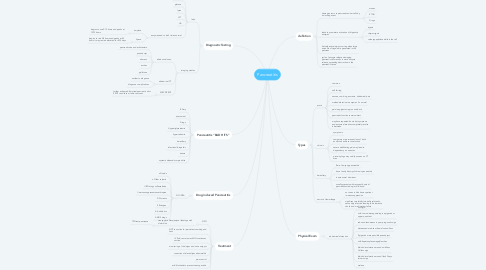
1. Diagnostic Testing
1.1. labs
1.1.1. CBC/Dif
1.1.2. glucose
1.1.3. lytes
1.1.4. LFT
1.1.5. UA
1.1.6. enzyme need to be 3 times normal
1.1.6.1. amylase
1.1.6.1.1. begins to rise 2-12 hours and peaks at 12-72 hours
1.1.6.2. lipase
1.1.6.2.1. begins to rise 4-8 hours and peaks at 24 hours it may remain elecated for 8-14 days
1.2. imaging studies
1.2.1. abdominal sono
1.2.1.1. pancreatic size and echotexture
1.2.1.2. psuedocyst
1.2.1.3. abscess
1.2.1.4. ascites
1.2.1.5. gallstone
1.2.2. abdominal CT
1.2.2.1. unclear to diagnose
1.2.2.2. diagnose complications
1.2.3. MRCP/ERCP
1.2.3.1. further enhance biliary tree/pancreatic duct ERCP can dilate or remove stones
2. Pancreatitis "BAD HITS"
2.1. Biliary
2.2. anatomical
2.3. Drugs
2.4. Hypertriglycerdemia
2.5. hypercalcemia
2.6. hereditary
2.7. infections/idiopathic
2.8. trauma
2.9. systemic disease/scorpion bite
3. Drug induced Pancreatitis
3.1. NO IDEA
3.1.1. n Nsaids
3.1.2. o Other valporin
3.1.3. I IBD drugs sulfaxsalaxine
3.1.4. I immunosuppresants azathropine
3.1.5. D Diuretics
3.1.6. E Estrogen
3.1.7. A Antibiotics
3.1.8. A AIDS drugs
4. Treatment
4.1. NPO
4.1.1. transpyloric Nasojenjunal feedings with older kids
4.1.1.1. TPN rest pancrease
4.2. NGT to suction for persistent vomiting and ileus
4.3. IV fluid, rest stomach NG continuous suction
4.4. monitoring of vital signs and urine outpyut
4.5. correction of electrolytes abnormalitis
4.6. pain control
4.7. acid blockade to prevent stress gastritis
4.8. nutiritonal support
5. defintion
5.1. damage occurs to pancreatic acinar cells by an inciting event
5.1.1. stones
5.1.2. ETOH
5.1.3. Drugs
5.2. leads to premature activation of digestive enzymes
5.2.1. trypsin
5.2.2. chymotrypsin
5.2.3. carboxypeptidase while in the cell
5.3. Autodigestive injury occurring when large amounts of trypsin are generated in the pancreas
5.4. cycle of enzyme release damaging pancreatic cells results in more enzyme release, spreading destruction in the pancreatic tissue
6. Types
6.1. acute
6.1.1. common
6.1.2. self limitng
6.1.3. nausea, vomiting, anorexia, abdominal pain
6.1.4. marked elevation in enzymes 3 x normal
6.1.5. pain in epigastric region and back
6.1.6. pancreatic function remains intact
6.1.7. may have repeated bouts but symptoms and enzyme elevations completely resolve in between
6.2. chronic
6.2.1. symptoms
6.2.2. temporary or permanent loss of both endocrine and exocrine fuction
6.2.3. severe debilitating pain may lead to dependency on narcotics
6.2.4. protein plugs may calcify as seen on CT scan
6.3. hereditary
6.3.1. Rare- few yong pancreatitis
6.3.2. has a family hisotry of chronic pancreatitis
6.3.3. is autosomal dominant
6.3.4. usually presents with recurrent bouts of pancreatitis starting in childhood
6.4. necrotic Hemorrhage
6.4.1. not seen in kids hemoc patient immunosuppression
6.4.2. significant morbidity/mortality related to secondary infection leading to bacteremia shock and multi system failure
7. Physical Exam
7.1. abdominal distention
7.1.1. not rigid
7.1.2. mild to moderate guarding in epigastric or upper quadrant
7.1.3. rebound tenderness is poor prognostic sign
7.1.4. decrteased or absent bowel sound Ileus
7.1.5. Epigastric mass possible pseudocyst
7.1.6. mild hepatosplenomegaly/ascites
7.1.7. bluish discoloration around umbilicus Cullens sign
7.1.8. bluish discoloration around flank Greys turners sign
7.1.9. melena
